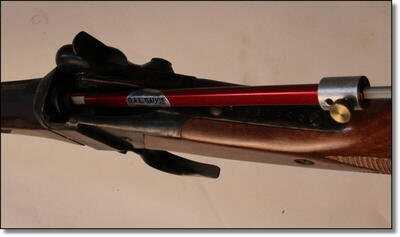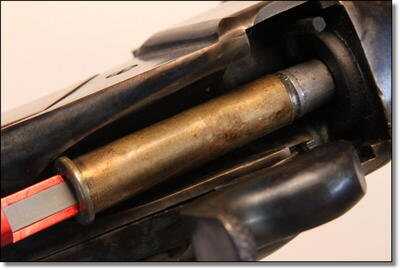| The Hornady Cartridge Overall Length Gauge or O.A.L Gauge, requires a specially modified case you have to order with your gauge. They are caliber specific and you must order one for each caliber you intend to measure. The gauge comes in both a straight version for bolt and most other rifles, and a bent version for lever guns and others that don’t have a way to measure straight from the back of the bore. When I have used this tool I have always measured from the tip of the bullet, but if you use the Hornady Bullet Comparator, you can measure from the ogive, which is actually the part of the bullet that engages the rifling. The curved version for lever guns uses a thick piano sized wound wire to play the measurement back and forth against the cleaning rod instead of the plastic pusher in the straight version. I found both to work equally as well. |
Direct from Hornady:
https://www.hornady.com/store/OAL-Gauges-and-Modified-Cases/
Also on Midway USA:
https://www.midwayusa.com
Join Hornady on Facebook
https://www.facebook.com/hornady
Obsession with accuracy drives you to think up some interesting ideas, one of those is Cartridge Overall Length. It is based on the premise that when a bullet is fired from its cartridge case before it engages the rifling, it is inherently unstable, and that in this “freebore,” the bullet can get cockeyed. When you remove as much of that jump as possible by seating the bullet closer to the rifling, it will eliminate this chaotic “freebore” and hit the rifling straighter and more consistently.
The careful hand-loader or re-loader will try to minimize that jump to the rifling as much as possible.
To measure this distance by hand, you have too loose fit a bullet into an empty cartridge case and seat the cartridge in the chamber, starting with the bullet out too far, so it touches the rifling and moves back into the case as you insert the cartridge.
I’ve tried to do it without this tool from Hornady and it is very difficult to get the bullet to be loose enough to go back and forth, and stay put after you press it against the rifling and remove it.
With a lead bullet especially, what you find is that the rifling marks the bullet and sticks to it so when you pull it out, the measurement is off. I’ve even traveled to the range with 20 rounds of 45-70 seated to what I proudly thought was 20 thousandths off the rifling, only to find that the rounds I made didn’t fit in the chamber because the bullet had stuck to the rifling when I pulled it out.
That is why Hornady made these Cartridge Overall Length Gauge tools. There is a straight one for bolt rifles and other types of actions where you can access the rear of the breech in a straight line, and a curved one for lever action guns and others types of actions where you can’t.
You should note that a loaded cartridge that has been made with the bullet as close to the rifling as possible, or as we say, at the longest “cartridge overall length” that the rifle will tolerate, often will not feed reliably from a magazine. When you load to maximum overall cartridge length, you should assume that you will be loading cartridges into the rifle one at a time.
Measuring Maximum Cartridge Overall Length
You will need both the gauge itself and a modified cartridge for the rifle you want to measure. You can’t use a regular empty cartridge because it has to be drilled and threaded for the tool. You can order these special cases directly from Hornady or on Midway, along with the tool itself. The pictures are of the 45-70 case I have used with the straight version of this tool for many years in my Sharps and Hi-Wall rifles.
The modified cartridge case screws onto the tool and you insert the cartridge into the breech. On a bolt action rifle that means you must remove the bolt, and on a rifle like the Pedersoli Sharps you see here, you just drop the block and insert the case.
Then you fish a cleaning rod in from the front of the muzzle to push on the front of the bullet to act as a counter pressure to the rod in the tool. With the two rods in hand and the bullet in the middle, you can feel for where the rifling begins. Then you lock the tool, and when you remove it, even if the bullet stuck to the rifling a little on the way out, you can put the bullet back to where the tool measured that first touch.
Hornady recommends that you seat your bullets 20 to 40 thousandths off the rifling but many people, especially in the black powder world where pressures are not as much of an issue, seat them even closer. Seating directly against the rifling, without any jump from the cartridge case, can lead to large pressure and velocity differences, and with modern smokeless powder it can lead to unsafe pressures, especially if you are already at the top of recommended loads.
After you have measured, you will then set your seating die so that the measurement on your finished cartridges matches the modified test cartridge, or is 20 or so thousandths less. If you are a serious hand loader, I suggest that you get a competition micrometer seating die made by Redding.
I have never used the bullet comparator tool that Hornady recommends you take measurements with instead of measuring off of the top of the bullet as you see here. The bullet comparator is a sleeve that has insert rings. When you slide the comparator and the right size ring over your bullet, it catches on the ogive, which is where the bullet turns inward from its main body to the point. Hornady makes bullets, so if they say that the ogive is a more reliable measurement indicator, I believe them, but I have never tried it. The ogive of course is what touches the rifling, not the tip, so that is what you are measuring with the overall cartridge length tool. Apples to apples, you probably would want to get the comparator.
Throat Erosion
The Hornady Overall Cartridge Length tool is also the only accurate way to measure throat erosion on your rifle. This can be a serious issue for competitive shooters who fire tens of thousands of rounds per year. Sometimes you find that a rifle that used to shoot great all of a sudden goes south on you with the same ammunition loaded the same way, and there is no outward explanation for it at all.
The controlled burn that happens when you fire a cartridge releases hot, pressurized gas. This, combined with a constant battering of lead or copper jacket, can and does damage the forcing cone inside your rifle chamber, and especially the ridges of rifling that stick up above the surface. Over time these ridges wear down. The result is that the bullet must travel farther to get to the rifling, and this can lead to a drop in accuracy because the bullet has too much time to get cockeyed before it engages.
This tool allows you to stay on top of your throat erosion by measuring it from time to time. If you find that the bullet engaging the rifling 20 thousands over what it used to, you can try loading the bullet in that much longer to see if you get back the accuracy you expect from the gun.
The careful hand-loader deals with a lot of variables in the quest for ultimate accuracy. Overall cartridge length, or what this really is, overall distance from the case head to the ogive, is an easy variable to measure, control and repeat. What bullet the gun likes, or what velocity it likes with its favorite bullet, can be agonizing to figure out, but maximum overall cartridge length is easy with this handy tool from Hornady.
Direct from Hornady:
https://www.hornady.com/store/OAL-Gauges-and-Modified-Cases/
Also on Midway USA:
https://www.midwayusa.com










what would be a new OAL for a .204 40 grain V-Max pushed by 27 grains of W748 powder and a 55 grain V-max fired from a Model 88 243 lever action. This should include the empty case max length and loaded case and bullet.
For years there were no gauges to set the bullet OAL, i always shot Magnum calibers&used a sharpes black marker to black out the bullet, & then you can tell when it is in the lands & back out your seating .020 to .030 to bleed off a little pressure & see where you get the best groups–No tool needed!!
I had the unique pleasure of shooting with Jerry Tierney, http://www.6mmbr.com/gunweek053.html a National Champion. We shot together for months and each time I would ask him questions he would answer. The result was I became more aware of what makes a good rifle, and good ammuntion.
It’s necessary for bullets to be “released” from the case (which upon firing performs as a gasket) however it’s critical that the case neck have .005 to .008 of space to expand. This means that tight chambers are ok as long as the neck can expand to release the bullet properly. Once this happens the gasses flowing around the bullet create a perfect alignment of the bullet with the bore. This is also predicated on the fact that bullets are not seated out to touch the lands. This would destroy such automatic precision alignment.
My personal experience came in the 70’s when I was tuning loads for a Remington 788. It shot everything well. But when I started to hone the loads for the rifle, it became a one hole machine. .030 jump was the magic number. Every one is slightly different. But once your powder charge has been determined, playing with seating depth isn’t rocket science. But tight necks are detrimental to accuracy.
Keep America Shooting
1. Not all loads benefit from seating at the lands, some perform better with a little bit of “jump”.
2. You should warn the readers that seating at the lands raises pressures significantly(it may be this increase in velocity, not the cockeye as you describe, that benefits some)…and care should be taken if they are already pushing max loads before seating at the lands…always best to start over with a load and slowly and safely work up if the oal is being lengthened.
3. A shooting buddy used the bullet comparator to perform an interesting study:
http://www.ar15.com/forums/t_6_42/325029_index.html
It is definitely useful to confirm a consistent seating depth of the base of the bullet in the case, as opposed to measurements at the tip of the bullet which can be off.